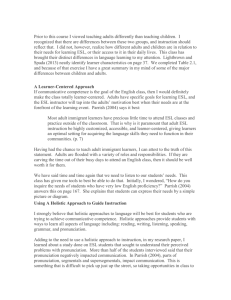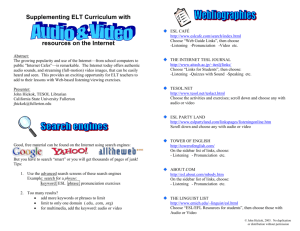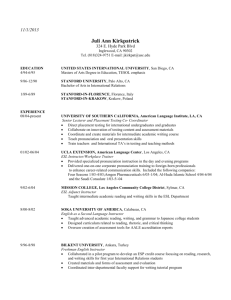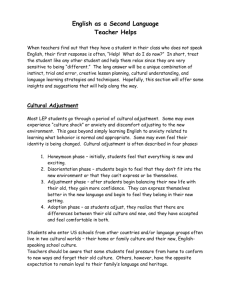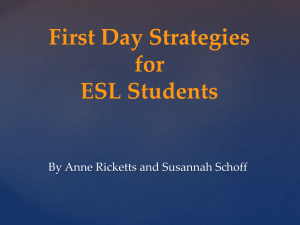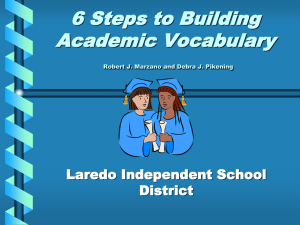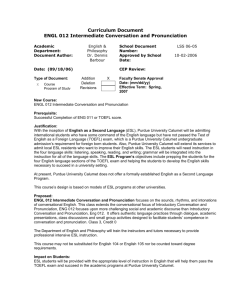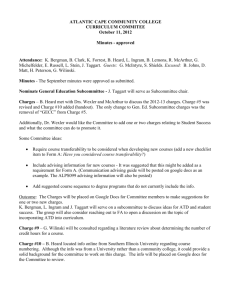To: All Arts and Sciences Faculty From: Susan Birren, Dean of Arts
advertisement
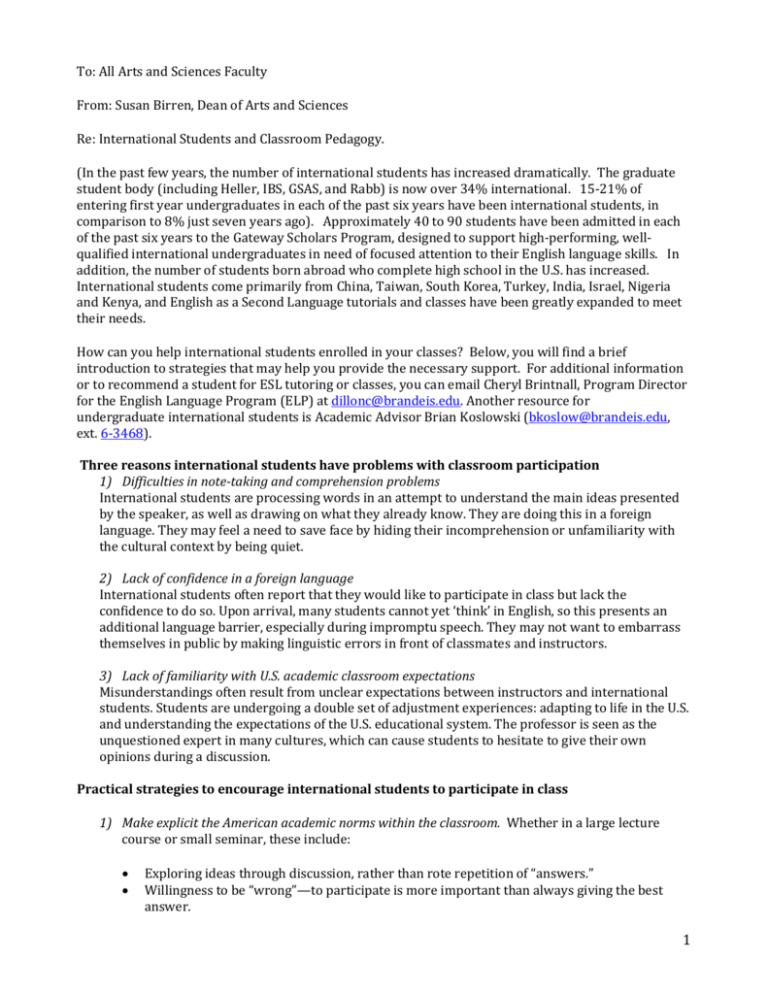
To: All Arts and Sciences Faculty From: Susan Birren, Dean of Arts and Sciences Re: International Students and Classroom Pedagogy. (In the past few years, the number of international students has increased dramatically. The graduate student body (including Heller, IBS, GSAS, and Rabb) is now over 34% international. 15-21% of entering first year undergraduates in each of the past six years have been international students, in comparison to 8% just seven years ago). Approximately 40 to 90 students have been admitted in each of the past six years to the Gateway Scholars Program, designed to support high-performing, wellqualified international undergraduates in need of focused attention to their English language skills. In addition, the number of students born abroad who complete high school in the U.S. has increased. International students come primarily from China, Taiwan, South Korea, Turkey, India, Israel, Nigeria and Kenya, and English as a Second Language tutorials and classes have been greatly expanded to meet their needs. How can you help international students enrolled in your classes? Below, you will find a brief introduction to strategies that may help you provide the necessary support. For additional information or to recommend a student for ESL tutoring or classes, you can email Cheryl Brintnall, Program Director for the English Language Program (ELP) at dillonc@brandeis.edu. Another resource for undergraduate international students is Academic Advisor Brian Koslowski (bkoslow@brandeis.edu, ext. 6-3468). Three reasons international students have problems with classroom participation 1) Difficulties in note-taking and comprehension problems International students are processing words in an attempt to understand the main ideas presented by the speaker, as well as drawing on what they already know. They are doing this in a foreign language. They may feel a need to save face by hiding their incomprehension or unfamiliarity with the cultural context by being quiet. 2) Lack of confidence in a foreign language International students often report that they would like to participate in class but lack the confidence to do so. Upon arrival, many students cannot yet ‘think’ in English, so this presents an additional language barrier, especially during impromptu speech. They may not want to embarrass themselves in public by making linguistic errors in front of classmates and instructors. 3) Lack of familiarity with U.S. academic classroom expectations Misunderstandings often result from unclear expectations between instructors and international students. Students are undergoing a double set of adjustment experiences: adapting to life in the U.S. and understanding the expectations of the U.S. educational system. The professor is seen as the unquestioned expert in many cultures, which can cause students to hesitate to give their own opinions during a discussion. Practical strategies to encourage international students to participate in class 1) Make explicit the American academic norms within the classroom. Whether in a large lecture course or small seminar, these include: Exploring ideas through discussion, rather than rote repetition of “answers.” Willingness to be “wrong”—to participate is more important than always giving the best answer. 1 Putting a thesis first in writing assignments (academic norms elsewhere put the thesis last). Plagiarism—why Americans value individualism in writing, what constitutes “cheating.” Other cultures openly encourage students to share answers and homework and borrow heavily from sources—none of which is considered plagiarism. Use of sources—how academic writing places a student’s viewpoint as the organizing one with experts to support a thesis. In other cultures, the experts come first; the writer’s perspective is not central. 2) Make lectures more accessible: Provide a lecture outline with main points to be covered to assist students in following the lecture and guiding note taking. Define new or unfamiliar words or concepts, and provide opportunities for clarification. Be on the lookout for jargon and try to reduce the use of idiomatic expressions and colloquialisms (e.g. “let’s cut to the chase”). Encourage students to ask questions about things they are not sure about. They may need practice or modeling before being comfortable showing their uncertainty. Be aware of your own speech habits; speed and clarity are particularly important. Use transitional phrases to signal new topics (e.g. “Now, that we’ve seen…let’s turn to…”). Consider recording your lecture and making it accessible online so students can hear it again if necessary. 3) Create opportunities for student participation: Help students gain confidence by allowing them to prepare responses or questions before class. Ask the whole class to write down their ideas or answers first and then call on a few students to give their responses verbally. Start with questions that elicit short factual answers, and then ask follow-up questions, and lastly opinion or evaluative questions. Explicitly seek international perspectives. Pose questions that students can discuss in pairs (or small groups) and then report back to the class. Develop tasks that increase opportunities for domestic and international students to interact. Notice small gestures of willingness to answer questions, and capitalize on them. Use an online forum like LATTE to provide an alternative way for those who are reluctant to speak up in class to share their opinions. Clarify expectations about student participation—be specific about what you want. 4) Give helpful feedback and create an atmosphere of support: Create a safe learning environment where students feel encouraged to contribute. Make students feel supported by learning their names. Ask sincere questions about the students’ home culture, but don’t assume that they are spokespersons representing their entire country or ethnicity. Give feedback that emphasizes the value of students’ contributions. Point out obvious mistakes that interfere with communication/meaning privately during office hours. Don’t ask if the students understand what you are saying because they will probably say ‘yes’; admitting confusion might challenge your competence as a professor. Instead, ask them to repeat the main ideas of what you’ve said to check comprehension. Invite a student to come to office hours, before they "need help". Many international students feel that going to office hours is a sign of weakness -- the professor will know that 2 they are not "perfect" students and are having trouble in the class. In other cultures, facultystudent contact is minimal so access is limited. Encourage students facing writing or participation challenges to come see you; ask them what are their expectations for participation or writing in their home cultures and explain the differences here and why they matter for success in the classroom. Provide a list of websites to improve pronunciation, if applicable. Refer students to the ESL Program for possible language proficiency support. What resources are available to ESL students to develop the (oral) communication skills they will need to succeed at Brandeis? The ESL Program offers individual tutorials to support the academic success of undergraduate and graduate students who are English language learners. Students are assigned to a tutor for the duration of the semester and meets on a weekly basis. Tutorials may focus on writing, reading, and/or oral skills. The ESL Program also offers speaking and writing skills classes for GSAS and IBS students. A diagnostic language test is given during orientation and student eligibility is based on the test results. The Writing Center offers writing tutorial services to all undergraduate and graduate students. Students can sign up on the basis of need, up to two weeks in advance, for help with papers, short assignments, ESL issues, and other writing requirements. Suggest the student sign up online at http://www.brandeis.edu/writingprogram/writingcenter/register.html Online Resources: 1) Arkoudis, Sophie. “Teaching International Students, Strategies to Enhance Learning.” Center for the Study of Higher Education, The University of Melbourne. Available online at: http://www.cshe.unimelb.edu.au/resources_teach/teaching_in_practice/docs/international .pdf 2) Kim, Soonhyang. “Teaching International Students Across the Curriculum: Supporting Academic Listening/Speaking.” The Ohio State University Faculty & TA Development. Available online at: http://ucat.osu.edu/Publications/intloral.html 3) Loach, Barbara L. “Helping International Students Succeed in University Programs.” Cedarville University. 2004 Available online at: http://www.cedarville.edu/Offices/AcademicEnrichment/~/media/Files/PDF/AcademicEnrichment/helping_your_international_students_to_succeed.ashx Recommended websites for students struggling with pronunciation: http://www.rachelsenglish.com/ Rachel’s English, Because Talking is Fun: my favorite site for pronunciation! http://www.learnersdictionary.com/ Merriam Webster’s ESL learner’s dictionary. Has a practice section of “Perfect Pronunciation Exercises” http://www.uiowa.edu/~acadtech/phonetics/# This site contains animated libraries of the phonetic sounds of English, German, and Spanish. Very helpful for learning more about consonant and vowel sounds. http://www.ted.com/ TED is a nonprofit devoted to Ideas Worth Spreading. The ‘interactive transcripts’ are very useful for imitation practice. Check out “Jay Walker on the world’s English mania”. 3

